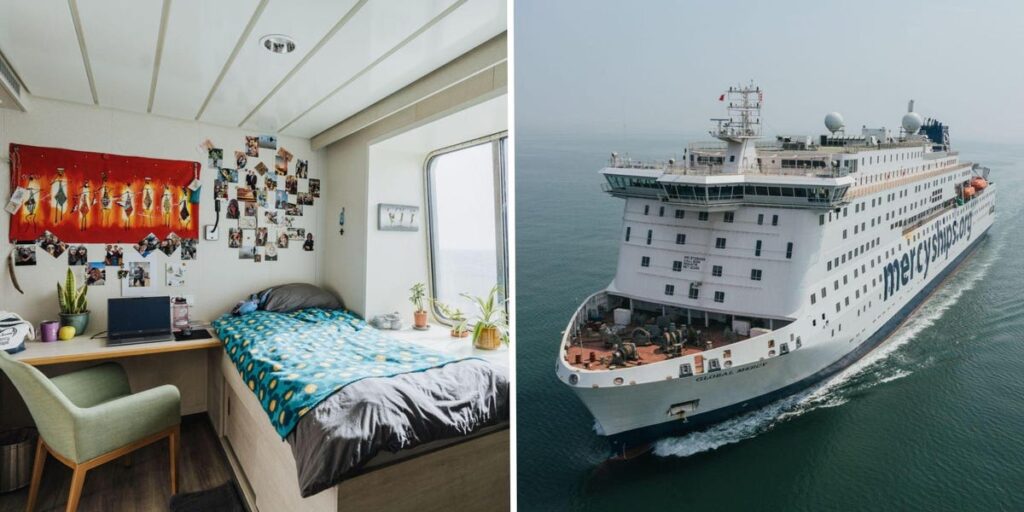subscribers. Become an Insider
and start reading now.
Have an account? .
- Nonprofit Mercy Ships converts cruise ships into floating hospitals.
- Its first ship was an Italian cruiseliner, while another was previously a train ferry.
- Its newest ship, Global Mercy, was built for the nonprofit — a $200 million project.
Not all cruise ships are created equal.
Instead of vacationers, some accommodate Olympic surfers, refugees, or, as is the case of Mercy Ships’ two vessels, folks in need of surgery.
Since 1978, Christian nonprofit Mercy Ships has operated a fleet of cruise ships turned floating hospitals, providing complimentary medical services to the countries they visit.
Onboard, reminders of the vessels’ past life, like pools and hair salons, remain in place. Instead of waterslides and theater shows, the ships now have schools, operating rooms, CT scanners, and ICU beds.
Mercy Ships has operated 5 vessels in its 47 years. The first was a converted Italian cruise liner.
The decision to use floating resorts was based on a simple fact: 40% of the world’s population lives on a coastline. “Coastal, rural cities have high medical deserts because they face extreme isolation and lack of infrastructure,” Kerry Peterson, the senior vice president of Mercy Ship’s US office, told Business Insider in an email.
The nonprofit provides its patients with dental care and seven surgery specialties, such as pediatric and women’s health — all for free.
Food, lodging, anesthesia, post-operation rehabilitation, and transportation are also complimentary, even if more than one operation is required.
In addition, the ships also offer specialized postgraduate training to locals through partnered residencies, fellowships, and rotations.
Mercy Ships currently has 2 vessels, Africa Mercy and Global Mercy.
According to Peterson, the nonprofit provided 4,746 surgeries and 13,312 dental procedures and trained more than 900 healthcare workers in 2024. Both ships exclusively operate in African nations.
Like any typical cruise liner, Africa and Global Mercy have an auditorium, pool, library, café, and store.
But instead of operating as vacations at sea, the two ships are more “akin to floating cities,” Peterson said, noting there are onboard mechanical and carpentry shops, post office, bank, gym, salon, and laundromat.
The nonprofit received a donation in early 2024 to fund the construction of a new vessel.
Its first ship, Africa Mercy, was previously a train ferry before finding a second life.
Mercy Ships acquired the Danish vessel, then known as Dronning Ingrid, in 1999. Following a $62 million refurbishment, it was re-deployed as Africa Mercy in 2007.
According to the nonprofit, as of June 2024, the floating hospital had performed more than 70,910 surgeries in countries such as Liberia, South Africa, Sierra Leone, Madagascar, and Cameroon.
The second ship, Global Mercy, was built for the nonprofit.
Mercy Ships began construction on its newest addition, Global Mercy, in 2015 — a $200 million investment, including the cost of equipment and the first patients.
The nonprofit touts the 571-foot-long vessel, launched in 2022, as the largest civilian hospital vessel in the world.
Larger than its predecessor, Global Mercy has 75,347 square feet of hospital space, including 102 acute care and seven ICU beds — in addition to a simulation lab for its training program.
It provides surgical care to about 1,500 patients annually, having so far served patients in Senegal, The Gambia, and Sierra Leone.
Global Mercy has 277 staterooms that can accommodate 640 crew.
Its solo, double, couple, family, guest, and VIP cabins see about 1,500 volunteers annually.
Peterson said Mercy Ships encourages its volunteers to explore the countries during their free time, whether grabbing dinner in town or staying overnight onshore — harkening back to the perks of a traditional cruise line.
Read the full article here


